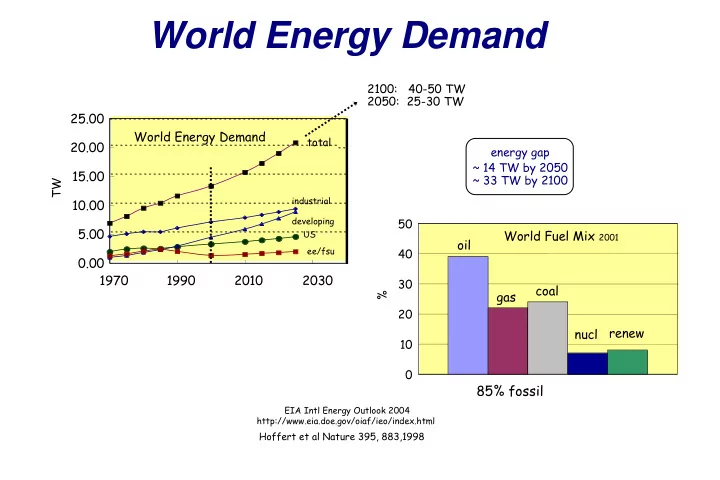

World Energy Demand 2100: 40-50 TW 2050: 25-30 TW 25.00 World Energy Demand total 20.00 energy gap ~ 14 TW by 2050 15.00 ~ 33 TW by 2100 TW industrial 10.00 developing 50 5.00 World Fuel Mix 2001 US oil ee/fsu 40 0.00 1970 1990 2010 2030 30 coal gas % 20 renew nucl 10 0 85% fossil EIA Intl Energy Outlook 2004 http://www.eia.doe.gov/oiaf/ieo/index.html Hoffert et al Nature 395, 883,1998
The Energy Gap • ~ 14 TW of additional power by 2050 • ~ 33 TW of additional power by 2100 2004 capacity: 13 TW fossil energy after oil production peaks, switch to gas and coal capture/store 22 Gtonnes of CO 2 /yr (current emissions) 12,500 km 3 at atmospheric pressure = volume of Lake Superior • • 600 times CO 2 injected in oil wells/yr to spur production • 100 times the natural gas drawn in and out of geologic storage/yr to smooth demand • 20,000 times CO 2 stored/yr in Norway’s Sleipner offshore reservior • no leaks: 1% leak rate nullifies storage in 100 yrs nuclear energy 14,000 1 GW e fission reactors - 1 new reactor/day for 38 years
Renewable Energy Solar energy gap ~ 14 TW by 2050 1.2 x 10 5 TW at Earth surface ~ 33 TW by 2100 600 TW practical Wind Biomass 2-4 TW extractable 5-7 TW gross all cultivatable land not used Tide/Ocean for food Currents 2 TW gross Hydroelectric 4.6 TW gross Geothermal 1.6 TW technically feasible 0.9 TW economically feasible 12 TW gross over land 0.6 TW installed capacity small fraction recoverable
Solar Energy Utilization H 2 O O 2 CO 2 QuickTime™ and a TIFF (Uncompressed) decompressor are needed to see this picture. sugar 500 - 3000 °C 50 - 200 °C heat engines space, water electricity generation heating natural process heat photosynthesis Solar Electric Solar Thermal Solar Fuel .001 TW PV $0.30/kWh w/o storage 1.4 TW solar fuel (biomass) 0.002 TW 11 TW fossil fuel 2 TW 1.5 TW electricity (present use) space and water $0.03-$0.06/kWh (fossil) heating ~ 14 TW additional energy by 2050
Solar Land Area Requirements 3 TW
“Solar Paint” d “Fooling “inexpensive particles into behaving as single crystals O ) n polymer donor ( MDMO-PPV O fullerene acceptor OMe OMe PCBM O O inexpensive processing, conformal layers
Energy Conversion Strategies Fuel Light Electricity Fuels Electricity SC CO 2 e Sugar H 2 O sc SC 2 H O 2 O H 2 O 2 Semiconductor/Liquid Photovoltaics Photosynthesis Junctions
Solar Thermal + Electrolyzer System
Solar-Powered Catalysts for Fuel Formation chlamydomonas moewusii 10 µ hydrogenase photosystem II 2H + + 2e - ⇔ H 2 oxidation reduction 2 H 2 O CO 2 4e - Cat Cat HCOOH O 2 CH 3 OH 4H + H 2 , CH 4
Control of Materials Properties Through Nanoscience biological physical mechanical Self-assembly of complex structures O 2 H 2 Hydrogen from water and sunlight demonstrated efficiencies 10-18% - in laboratory +
Basic Research Needs for Solar Energy • The Sun is a singular solution to our future energy needs - capacity dwarfs fossil, nuclear, wind . . . - sunlight delivers more energy in one hour than the earth uses in one year - free of greenhouse gases and pollutants - secure from geo-political constraints • Enormous gap between our tiny use of solar energy and its immense potential - Incremental advances in today’s technology will not bridge the gap - Conceptual breakthroughs are needed that come only from high risk-high payoff basic research • Interdisciplinary research is required physics, chemistry, biology, materials, nanoscience • Basic and applied science should couple seamlessly
Summary • Need for Additional Primary Energy is Apparent • Case for Significant (Daunting?) Carbon-Free Energy Seems Plausible (Imperative?) Scientific/Technological Challenges • Provide Disruptive Solar Technology: Cheap Solar Fuel Inexpensive conversion systems, effective storage systems Policy Challenges • Energy Security, National Security, Environmental Security, Economic Security • Is Failure an Option? Will there be the needed commitment?
Recommend
More recommend